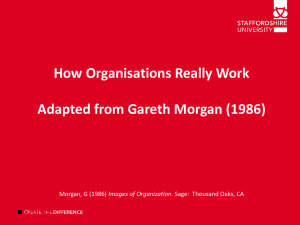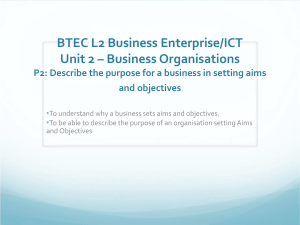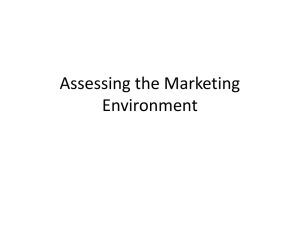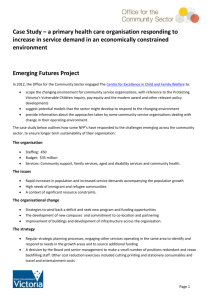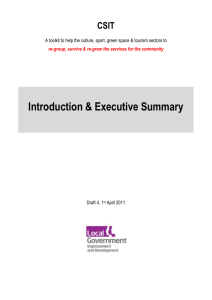CSIT - Document 2
advertisement
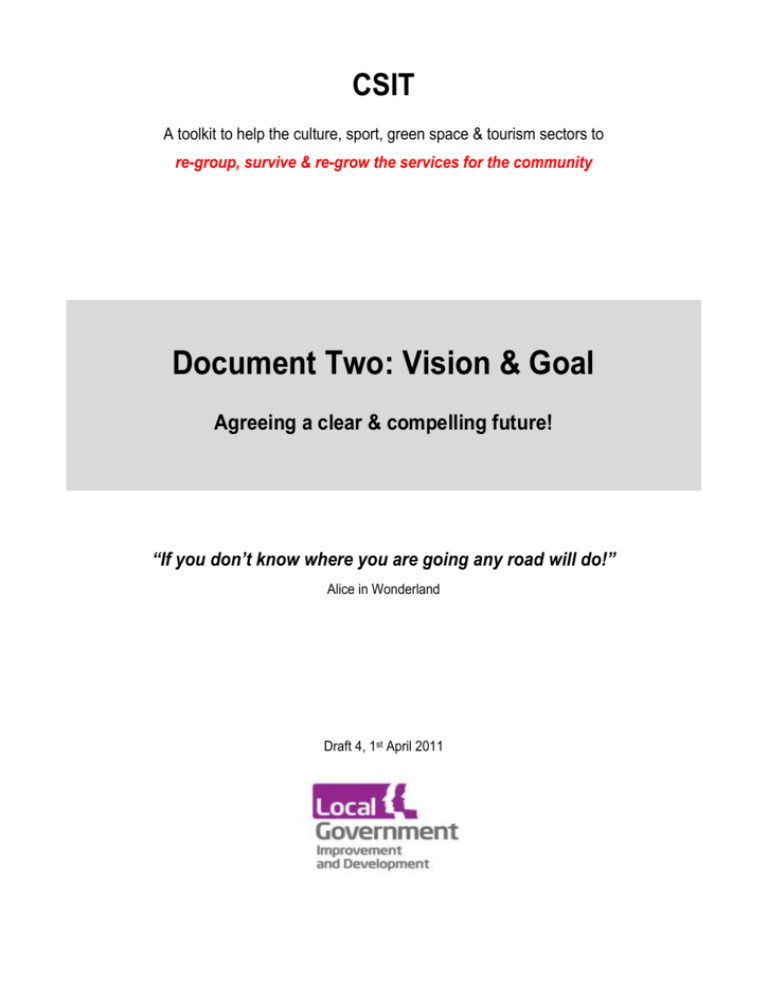
CSIT A toolkit to help the culture, sport, green space & tourism sectors to re-group, survive & re-grow the services for the community Document Two: Vision & Goal Agreeing a clear & compelling future! “If you don’t know where you are going any road will do!” Alice in Wonderland Draft 4, 1st April 2011 Vision & Goal A Vision for Excellence The following Vision for Excellence defines what ‘excellence’ means for strategic culture, sport, green space & tourism organisations within the public sector. It is designed to be high-level & aspirational and the basis for organisational change goals & all improvement activity. Excellent organisations are those which… Achieve sustained positive & beneficial results for the community, its people and the wider environment (EFQM Excellence Model 2010) This is achieved through… Continual innovation in the services offered to the community and the marketing methods and… Continuous improvement of all aspects of the way in which the organisation & its partnerships work to achieve greater capability & efficiency The following visionary characteristics provide long-term direction for this continuous improvement activity for strategic culture, sport, green space & tourism organisations within the public sector. As organisations & their partners improve in relation to these characteristics, their capability to achieve sustainable results for all stakeholders will grow. 1. Outcomes focus Excellent organisations understand that their existence depends upon achieving tangible & sustainable outcomes for the communities they serve, define what outcomes they are striving to achieve based on identified needs & expectations, focus all activities on achieving these results and base all decisions on facts. 2. Leadership which makes a difference Excellent organisations have visionary, forward-thinking, ethical, flexible, influential & self-determined leaders who lead by example, are passionate about making a difference to the community through the services, committed to working with civil society, not motivated by building empires, honest brokers, skilled facilitators & advocates and willing to think & act differently. 3. Community & civil society at the heart Excellent organisations understand & respond to needs & expectations of the community, put the community at the heart of the service, build capacity within civil society organisations and deliver the services in partnership with the community bodies & volunteers. 4. Innovation and social entrepreneurialism Excellent organisations nurture, generate & make use of innovation in relation to services, marketing, partnerships and the way in which the organisation works (to achieve improvement in effectiveness, economy & efficiency) and take advantage of emerging & unusual opportunities to fund, develop & deliver services which meet the needs of the community. 2 Vision & Goal 5. Partnership working Excellent organisations develop trusting, value adding, mutually beneficial & innovative partnerships with public sector, commercial sector & civil society organisations to develop & deliver services which meet the needs & expectations of the community. 6. Efficiency & value for money Excellent organisations understand what ‘value’ means, use techniques to diagnose non-value adding activity & enhance value, proactively engage in collaborative activity, explore creative opportunities for funding, including commissioning, and make optimum use of assets. 7. One team Excellent organisations develop true ownership amongst its people & partners, creating one team which is passionate about meeting the needs of the community, collectively responsible for results and willing & able to change in response to the changing external environment. 8. Meet the needs of people Excellent organisations commit to personal learning, development, improvement & staff care, in line with the present & future needs of the organisation & the people. 9. Collaboration Excellent organisations create & make the best use of opportunities for collaborative working with public sector, commercial sector & civil society organisations to achieve enhanced efficiency & value for money, a ‘total place’ approach to services and mutual peer challenge & support at organisational, team & individual level. 10. Knowledge management Excellent organisations understand that the knowledge of people within the organisation & within partner networks is a key asset & key part of the service, and identify, develop, retain, share & make the best use of this resource. 3 Vision & Goal Developing your Vision & Organisational Goals Developing, crystallising, agreeing & bringing to life your Vision & long-term changes that you want to take place within your organisation is a significant part of the improvement process. It ensures that your improvement activity is focussed in the right direction. It also helps to energise and motivate people to keep making improvements and to use the improvement tools in a positive way. The following questions & techniques will help you lead your Vision & Organisational Goal setting workshops. These need to involve all managers. Ideally they will take place every year as part of the strategy review & development process. Firstly discuss, revisit and bring to life the Vision for Culture, Sport, Green Space and/or Tourism… 1. What are we and our partners aiming to achieve ultimately through our work? 2. How will this benefit the community? 3. What do want to see, hear and feel about our organisation….from our rocking chair! 4. What is really exciting for us about this? 4 Vision & Goal Now, consider what type of organisation or partnership you need to be in the future in order to pursue the Vision… 5. Imagine it is three years from now. Give yourself permission to dream. You have been completely successful in changing your organisation… it is now a role model, with the capacity to achieve excellent results…. What tangible changes have been made? What does everything look, sound and feel like? What are other people saying to you? 6. What is exciting about these goals? 7. What would happen if you didn’t achieve these goals? 8. How will achieving these goals help to achieve your Vision and long-term overarching outcomes? 5 Vision & Goal 9. In what way are these goals aligned to your organisation’s core values? 10. How do these change goals support the priorities of the wider organisation or partnership? 11. How will you measure your success in achieving each goal? 12. Who will be champions of the change goals? What does this mean? 13. Who will lead each change goal? 14. Who will document the change goals and success criteria? 15. How will you communicate the change goals? 6 Vision & Goal 16. On a scale of one to 10….10 being passionately committed to these goals, 1 being not committed at all…. where are you? What would it take to get you to a 10? 7

